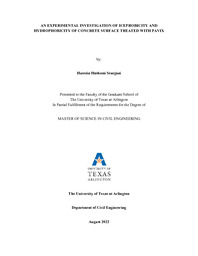
ATTENTION: The works hosted here are being migrated to a new repository that will consolidate resources, improve discoverability, and better show UTA's research impact on the global community. We will update authors as the migration progresses. Please see MavMatrix for more information.
Show simple item record
| dc.contributor.advisor | Yu, Xinbao | |
| dc.creator | Hashemi Senejani, Hussein | |
| dc.date.accessioned | 2023-06-30T16:07:37Z | |
| dc.date.available | 2023-06-30T16:07:37Z | |
| dc.date.created | 2022-08 | |
| dc.date.issued | 2022-08-15 | |
| dc.date.submitted | August 2022 | |
| dc.identifier.uri | http://hdl.handle.net/10106/31450 | |
| dc.description.abstract | High ice adhesion is a significant problem in several industries. The majority of practical issues brought on by ice adhesion are still not fully resolved, and the ice-adhesion mechanism is still poorly understood. Ice adhesion is a complex phenomenon that becomes more intricate when salt is involved, as in many marine cases. Reducing ice adhesion by generating hydrophobic surfaces might be advantageous in many applications as a passive ice removal strategy. Lowering adhesion may reduce friction, abrasion, and damage to structures in a maritime environment, as well as any surface prone to ice development. This process may also be utilized as a more environmentally friendly road deicing procedure. To estimate the effects of a topical treatment on shear adhesion of ice on concrete surfaces, a series of direct shear tests were performed on concrete treated with a waterproofing product named PAVIX. Chem-Crete PAVIX is a multi-crystallization enhancer, a patented, dual-crystalline engineered waterproofing technology. TxDOT standard Class S concrete is used as control concrete and mixed at two water-cement ratios, 0.45 and 0.43. Ice-adhesion shear tests were performed on control and PAVIX-treated concrete disks using a customized direct shear test device at two controlled sub-freezing temperatures, 30 oF and 13 oF. In addition, thermal conductivity was measured using a KD2 RK-1 heat probe. Specific heat capacity was measured using a custom-made calorimetric box. Water repellent property and contact angle were measured using a tensiometer under static and receding conditions. Results show an excellent reduction of ice-adhesion for PAVIX-treated concrete combined with surface hydrophobicity. The measured results quantify the anti-icing benefit of PAVIX treatment and provide insights into understanding the anti-icing mechanism of the treated concrete. Further investigations must follow to establish a standard for the testing methods used. With increased tests and variations in the test plan, the ice concrete adhesion would be better understood. | |
| dc.format.mimetype | application/pdf | |
| dc.language.iso | en_US | |
| dc.subject | Concrete | |
| dc.subject | Ice adhesion | |
| dc.subject | Shear strength | |
| dc.subject | Pavement deicing | |
| dc.title | An Experimental Investigation Of Icephobicity And Hydrophobicity Of Concrete Surface Treated With PAVIX | |
| dc.type | Thesis | |
| dc.date.updated | 2023-06-30T16:07:37Z | |
| thesis.degree.department | Civil Engineering | |
| thesis.degree.grantor | The University of Texas at Arlington | |
| thesis.degree.level | Masters | |
| thesis.degree.name | Master of Science in Civil Engineering | |
| dc.type.material | text | |
| dc.creator.orcid | 0000-0003-3326-2069 | |
| local.embargo.terms | 2023-08-01 | |
| local.embargo.lift | 2023-08-01 | |
Files in this item
- Name:
- HASHEMISENEJANI-THESIS-2022.pdf
- Size:
- 5.480Mb
- Format:
- PDF
This item appears in the following Collection(s)
Show simple item record


